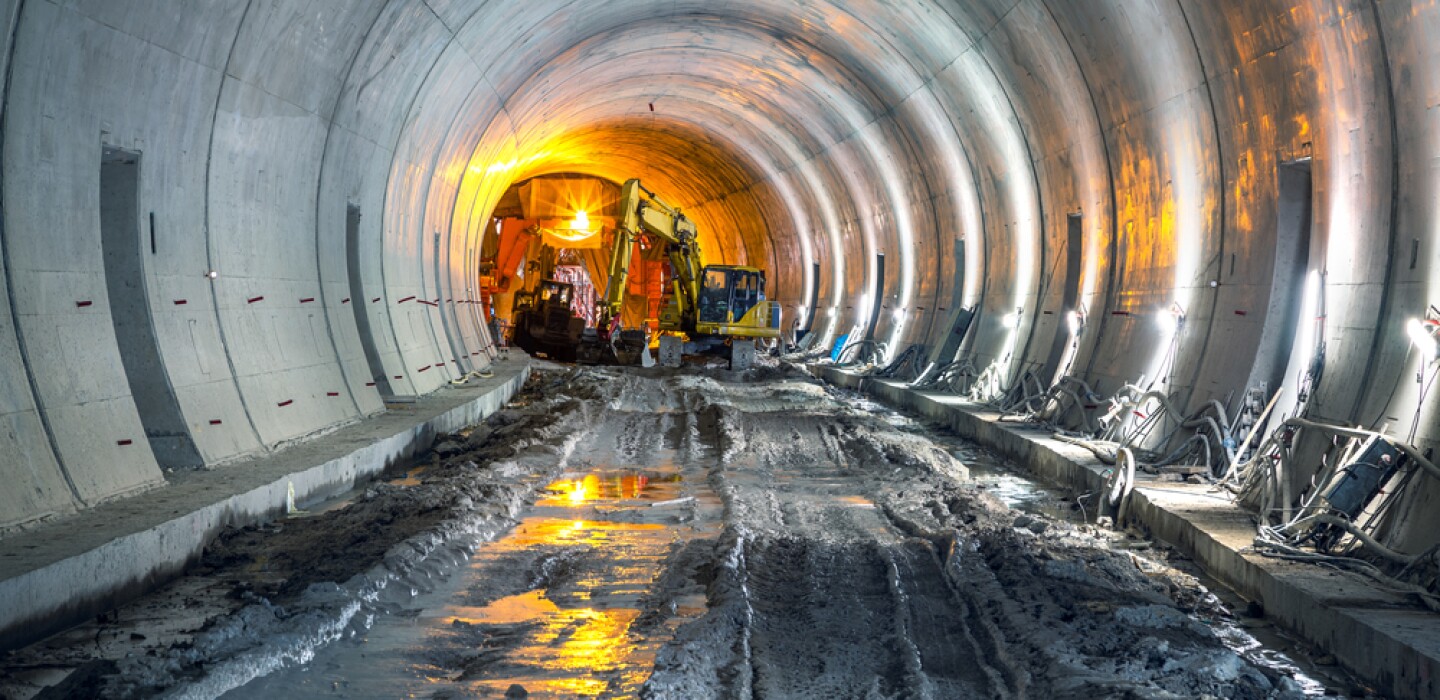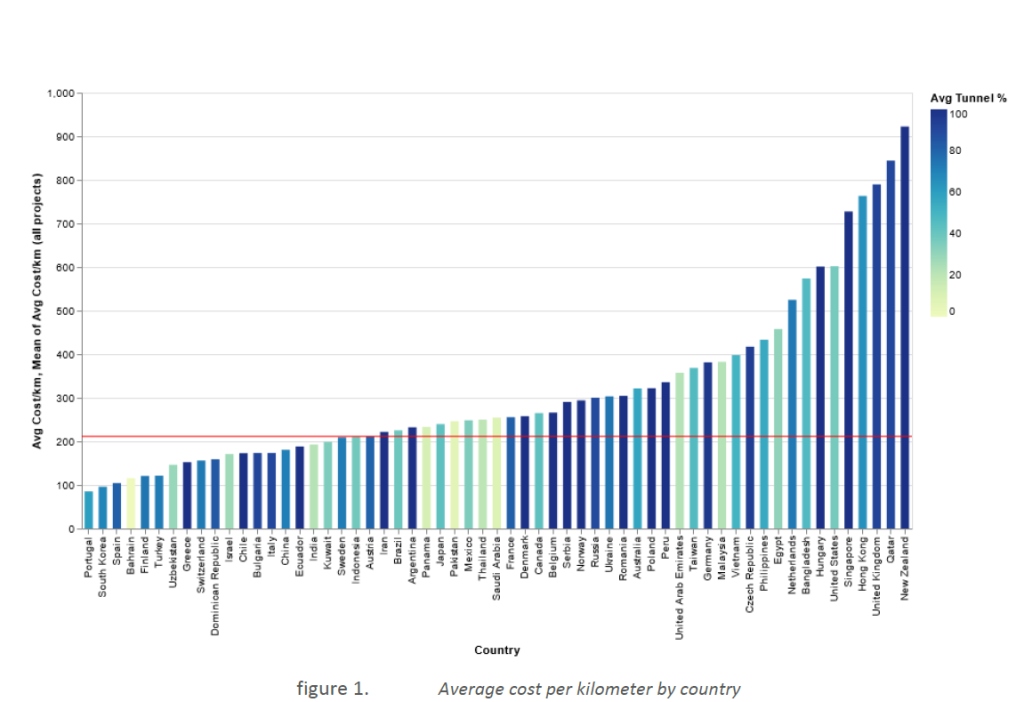Comments
- No comments found

Building mass transit infrastructure in the United States is considerably more expensive than in other countries.
Why? Eric Goldwyn, Alon Levy, Elif Ensari and Marco Chitti dig down into case studies to get some answers in Transit Costs Project: Understanding Transit Infrastructure Costs in American Cities (New York University, Marron Institute of Urban Management).
The main focus of the report is to look in some detail at extensions of mass transit in Boston and New York, and also at projects in Sweden, Italy, Istanbul and Istanbul. The disadvantage of a case study method, of course, is that you need to be cautious about drawing conclusions from a small number of examples. The counterbalancing advantage is that you can dig deeply into the details of each individual case. But they do offer some big-picture statistics as well..
The problem of high costs is nationwide. According to our database (Transit Costs Project .d.) of more than 900 projects in 59 countries, including Hong Kong, the United States is the sixth most expensive country in the world to build rapid-rail transit infrastructure. This is slightly misleading, however, because construction costs scale with the percentage of tunneled track, which is more expensive than building rail at grade. The five countries with greater average costs than the United States are building projects that are more than 65% tunneled. In the United States, on the other hand, only 37% of the total track length is tunneled (Figure 1). … Therefore, it is valuable to understand what it is about the physical, institutional, and social situation of American cities that frustrates subway expansion dreams.

What kinds of factors explain the difference?
The US rail transit stations are often “overbuilt,” meaning that they are built much longer than the actual train platforms, and are also sometime built with nice high vaulted ceilings. In addition, the stations in Boston and New York were not standardized: for example, “three stations [in New York] used two different escalator contractors and have a different number of exits, crossovers, and elevators, all of which raise design costs because each station needs to be customized rather than using a standard design that is modified slightly.” Thus, when you compare the costs of “systems and station finishes” to the costs of “tunnels and station civil works,” the ratio of those costs is about 50:50 in New York, but 25:75 in Paris Milan, and Sweden.
Labor is a much larger share of transit construction costs in the US: “In New York as well as in the rest of the American Northeast, labor is 40-60% of the project’s hard costs, according to cost estimators, current and former agency insiders, and consultants with knowledge of domestic projects. Labor costs in our low-cost cases, Turkey, Italy, and Sweden are in the 19-30% range; Sweden, the highest-wage case among them, is 23%. The difference between labor at 50% of construction costs and labor at 25%, holding the rest constant, is a factor of 3 difference in labor costs …”
Overlapping and redundant bureaucracies also add to US transit construction costs. “[W]e also found overstaffing of white-collar labor in New York and Boston (by 40-60% in Boston), due to general inefficiency as well as interagency conflict, while little of the difference (at most a quarter) comes from differences in pay. … We have identified numerous cost drivers that stem from procurement norms in the United States. These include a pervasive culture of secrecy and adversarialism between agencies and contractors, a lack of internal capacity at agencies to manage contractors, insufficient competition, and a desire to privatize risk that leads private contractors to bid higher. Overall, this raises costs by a factor of 1.85, with the extra money going to red tape, wasted contingencies, paying workers during delays, defensive design, and, owing to contractor risk, and profit.”
There are also “soft costs”: “Soft costs include design, planning, force account, insurance, construction management, and contingencies; breakdowns differ by city. Nonetheless, we harmonized definitions around third-party design, planning, and project management costs. Those add 5-10% on top of the hard contract costs in our comparison cases, most commonly 7-8%. But in English-speaking countries, soft costs add much more; for Second Avenue Subway, it was 21%.”
Thus, if you want to know why it’s so hard and costly for US cities to build transit systems, and why such systems seem to be built and extended in other cities much more easily, a big part of the issue is that the model that US cities have used for building such infrastructure has led to high costs.
A common proposal here is to try to set up construction contracts so that the risk of higher costs and cost overruns would be carried by private firms, not by taxpayers. The authors find little evidence that these kinds of reforms work:
Moreover, many ongoing reforms hailed as steps forward, which we call the globalized system in the Sweden report, at best do nothing and at worst are actively raising costs; these reforms all aim to privatize risk and have been popular throughout the English-speaking world, and while consultants, managers, and large contractors like them, costs grow sharply wherever they are implemented, such as England, Singapore, Hong Kong, and Canada. … The good news is that high-cost countries can adopt the practices of low-cost countries and build subways at costs more in line with those of low-cost Scandinavia, Southern Europe, and Turkey. To do this, it requires rethinking design and construction techniques, labor utilization, procurement, agency processes, and the use of private real estate, consultants, and contingencies. If it implements the best practices we detail in the rest of the overview, the highest-cost city in our database, New York, can reduce its construction costs to match those of Italy and match or even do better than Scandinavia.”
Of course, the US inability to build transit at a reasonable cost is part of a bigger problem: along a variety of dimensions, the US economy has a diminished ability to build, whether we are talking about mass transit, green energy, or housing.
For example, if the United States is serious as a society about a vast expansion of solar and wind energy (a proposition I find myself doubting), then we will need not only very large commitments of land to solar and wind projects, but also a vast physical expansion of the electrical grid–along with facilities for manufacturing and recycling the equipment and a willingness to mine for the copper and other raw materials needed. A report on some of the permitting reforms needed for those steps to happen is here.
Similarly, if we are serious as a society about affordable housing (a proposition it is also possible to doubt), then many cities need a vast expansions of their housing stock, not mostly built at the extreme outer edges of cities where land is cheap, but instead focused on locations within city boundaries where some combination of underused office and commercial space, surface parking lots, and even certain areas in residential neighborhoods (say, those near mass transit or the empty airspace above some local shops) will need to be committed to additional housing units.
None of this needs to mean a free-for-all of building. Zoning can still matter! But current US rules for construction in many areas often look remarkably like the rules you would have in place if you wanted to discourage and slow construction, and raise its costs, rather than the roles you would have in place to facilitate such projects.
Timothy Taylor is an American economist. He is managing editor of the Journal of Economic Perspectives, a quarterly academic journal produced at Macalester College and published by the American Economic Association. Taylor received his Bachelor of Arts degree from Haverford College and a master's degree in economics from Stanford University. At Stanford, he was winner of the award for excellent teaching in a large class (more than 30 students) given by the Associated Students of Stanford University. At Minnesota, he was named a Distinguished Lecturer by the Department of Economics and voted Teacher of the Year by the master's degree students at the Hubert H. Humphrey Institute of Public Affairs. Taylor has been a guest speaker for groups of teachers of high school economics, visiting diplomats from eastern Europe, talk-radio shows, and community groups. From 1989 to 1997, Professor Taylor wrote an economics opinion column for the San Jose Mercury-News. He has published multiple lectures on economics through The Teaching Company. With Rudolph Penner and Isabel Sawhill, he is co-author of Updating America's Social Contract (2000), whose first chapter provided an early radical centrist perspective, "An Agenda for the Radical Middle". Taylor is also the author of The Instant Economist: Everything You Need to Know About How the Economy Works, published by the Penguin Group in 2012. The fourth edition of Taylor's Principles of Economics textbook was published by Textbook Media in 2017.
Leave your comments
Post comment as a guest